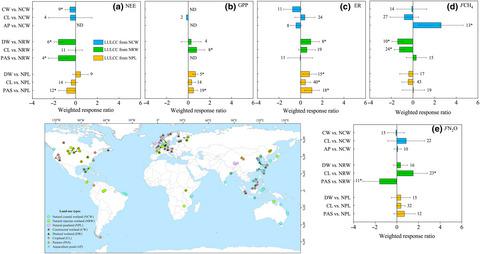当前位置:
X-MOL 学术
›
Glob. Change Biol.
›
论文详情
Our official English website, www.x-mol.net, welcomes your feedback! (Note: you will need to create a separate account there.)
Conversion of coastal wetlands, riparian wetlands, and peatlands increases greenhouse gas emissions: A global meta-analysis.
Global Change Biology ( IF 11.6 ) Pub Date : 2019-11-22 , DOI: 10.1111/gcb.14933 Lishan Tan 1 , Zhenming Ge 1, 2 , Xuhui Zhou 3 , Shihua Li 1 , Xiuzhen Li 1, 2 , Jianwu Tang 1, 2
Global Change Biology ( IF 11.6 ) Pub Date : 2019-11-22 , DOI: 10.1111/gcb.14933 Lishan Tan 1 , Zhenming Ge 1, 2 , Xuhui Zhou 3 , Shihua Li 1 , Xiuzhen Li 1, 2 , Jianwu Tang 1, 2
Affiliation

|
Land-use/land-cover change (LULCC) often results in degradation of natural wetlands and affects the dynamics of greenhouse gases (GHGs). However, the magnitude of changes in GHG emissions from wetlands undergoing various LULCC types remains unclear. We conducted a global meta-analysis with a database of 209 sites to examine the effects of LULCC types of constructed wetlands (CWs), croplands (CLs), aquaculture ponds (APs), drained wetlands (DWs), and pastures (PASs) on the variability in CO2 , CH4 , and N2 O emissions from the natural coastal wetlands, riparian wetlands, and peatlands. Our results showed that the natural wetlands were net sinks of atmospheric CO2 and net sources of CH4 and N2 O, exhibiting the capacity to mitigate greenhouse effects due to negative comprehensive global warming potentials (GWPs; -0.9 to -8.7 t CO2 -eq ha-1 year-1 ). Relative to the natural wetlands, all LULCC types (except CWs from coastal wetlands) decreased the net CO2 uptake by 69.7%-456.6%, due to a higher increase in ecosystem respiration relative to slight changes in gross primary production. The CWs and APs significantly increased the CH4 emissions compared to those of the coastal wetlands. All LULCC types associated with the riparian wetlands significantly decreased the CH4 emissions. When the peatlands were converted to the PASs, the CH4 emissions significantly increased. The CLs, as well as DWs from peatlands, significantly increased the N2 O emissions in the natural wetlands. As a result, all LULCC types (except PASs from riparian wetlands) led to remarkably higher GWPs by 65.4%-2,948.8%, compared to those of the natural wetlands. The variability in GHG fluxes with LULCC was mainly sensitive to changes in soil water content, water table, salinity, soil nitrogen content, soil pH, and bulk density. This study highlights the significant role of LULCC in increasing comprehensive GHG emissions from global natural wetlands, and our results are useful for improving future models and manipulative experiments.
中文翻译:

沿海湿地,河岸湿地和泥炭地的转换增加了温室气体的排放:一项全球荟萃分析。
土地利用/土地覆盖变化(LULCC)通常会导致自然湿地退化,并影响温室气体(GHG)的动态。但是,目前尚不清楚各种LULCC类型的湿地温室气体排放量的变化幅度。我们对全球209个地点的数据库进行了荟萃分析,以研究LULCC类型的人工湿地(CW),农田(CL),水产养殖池塘(AP),排水湿地(DW)和牧场(PAS)的影响。天然沿海湿地,河岸湿地和泥炭地的CO2,CH4和N2 O排放量的变化性。我们的结果表明,自然湿地是大气中CO2的净汇和CH4和N2 O的净来源,由于全球综合变暖潜势(GWPs)为负,因此具有缓解温室效应的能力; -0.9至-8.7 t CO2 -eq ha- 1年1)。相对于自然湿地,所有LULCC类型(沿海湿地的CW除外)使净CO2吸收量减少了69.7%-456.6%,这是由于生态系统呼吸的增加相对于初级总产值的微小变化所致。与沿海湿地相比,化学废物和AP显着增加了CH4排放。与河岸湿地相关的所有LULCC类型均显着降低了CH4排放。当泥炭地转换为PAS时,CH4排放量显着增加。CLs以及泥炭地的DWs显着增加了自然湿地中N2 O的排放量。结果,与自然湿地相比,所有LULCC类型(河岸湿地的PAS除外)导致GWP显着提高了65.4%-2,948.8%。LULCC温室气体通量的变化主要对土壤含水量,地下水位,盐度,土壤氮含量,土壤pH和堆积密度的变化敏感。这项研究强调了LULCC在增加全球自然湿地的综合温室气体排放中的重要作用,我们的结果对于改进未来的模型和操纵性实验很有用。
更新日期:2020-01-02
中文翻译:

沿海湿地,河岸湿地和泥炭地的转换增加了温室气体的排放:一项全球荟萃分析。
土地利用/土地覆盖变化(LULCC)通常会导致自然湿地退化,并影响温室气体(GHG)的动态。但是,目前尚不清楚各种LULCC类型的湿地温室气体排放量的变化幅度。我们对全球209个地点的数据库进行了荟萃分析,以研究LULCC类型的人工湿地(CW),农田(CL),水产养殖池塘(AP),排水湿地(DW)和牧场(PAS)的影响。天然沿海湿地,河岸湿地和泥炭地的CO2,CH4和N2 O排放量的变化性。我们的结果表明,自然湿地是大气中CO2的净汇和CH4和N2 O的净来源,由于全球综合变暖潜势(GWPs)为负,因此具有缓解温室效应的能力; -0.9至-8.7 t CO2 -eq ha- 1年1)。相对于自然湿地,所有LULCC类型(沿海湿地的CW除外)使净CO2吸收量减少了69.7%-456.6%,这是由于生态系统呼吸的增加相对于初级总产值的微小变化所致。与沿海湿地相比,化学废物和AP显着增加了CH4排放。与河岸湿地相关的所有LULCC类型均显着降低了CH4排放。当泥炭地转换为PAS时,CH4排放量显着增加。CLs以及泥炭地的DWs显着增加了自然湿地中N2 O的排放量。结果,与自然湿地相比,所有LULCC类型(河岸湿地的PAS除外)导致GWP显着提高了65.4%-2,948.8%。LULCC温室气体通量的变化主要对土壤含水量,地下水位,盐度,土壤氮含量,土壤pH和堆积密度的变化敏感。这项研究强调了LULCC在增加全球自然湿地的综合温室气体排放中的重要作用,我们的结果对于改进未来的模型和操纵性实验很有用。


























 京公网安备 11010802027423号
京公网安备 11010802027423号